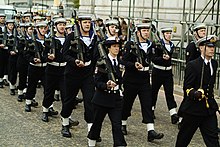Cap badge
Cap badges are a modern form of heraldry and their design generally incorporates highly symbolic devices.
Officers wearing a more elaborate version compared to that of soldiers, made using gold thread and has a more three-dimensional design.
However, since the practice of British soldiers operating in theatre with regimental headdress (i.e. peaked cap, beret) has all but died out, the wearing of these has become much less common in recent years.
The cap badge is positioned differently depending on the form of headdress: Soldiers of the Gloucestershire Regiment and subsequently the Royal Gloucestershire, Berkshire and Wiltshire Regiment wore a cap badge on both the front and the rear of their headdress, a tradition maintained by soldiers in The Rifles when in service dress.
The back badge is unique in the British Army and was awarded to the 28th Regiment of Foot for their actions at the Battle of Alexandria in 1801.
Additional items that reflect a regiment's historical accomplishments, such as backing cloth and hackles, may be worn behind the cap badge.
For a period leading up to Remembrance Day artificial poppies are worn by many people in the United Kingdom and Canada to commemorate those killed in war.
On forage caps the paper petals are fitted under the left hand chin strap button.
Cap badges in the Royal Air Force differ in design between those of commissioned officers and other ranks.
Distinct cap badges identify members' personnel branch or, in the case of infantry and armoured soldiers, regimental affiliation.
In the late nineteenth century, this device on a blue circle was listed as the equivalent of the roundel that appeared on headgear of many European armies.
For enlisted men, a small version of the officer's insignia centered on a disk is worn on the front.
For garrison caps, generally the rank insignia is worn, but recent regulations call for the wear of the DUI.
Petty Officers wear a silver fouled anchor within a gold circle, with St Edward's Crown above the ring as their cap badge.
Those of commissioned officers below the rank of colonel are split in two, the crown and lion atop, but separated from, the globe and laurels.
Blackened or subdued versions of both variants, those of officers and other ranks, are worn on berets, with combat uniforms.





